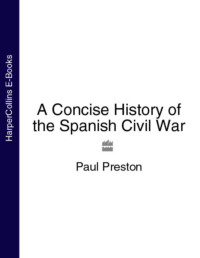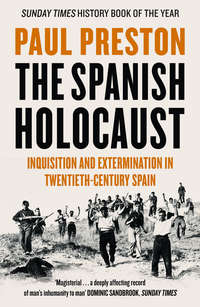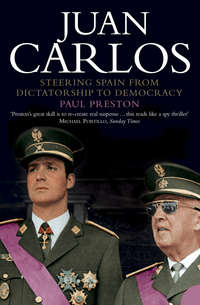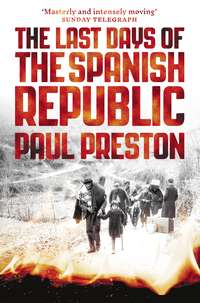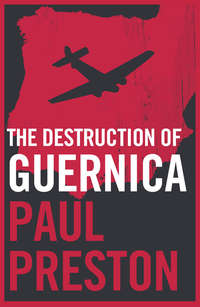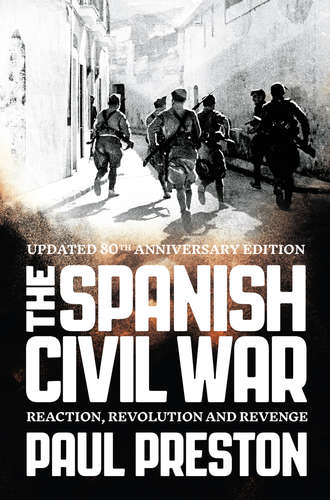
Полная версия
The Spanish Civil War: Reaction, Revolution and Revenge
In the aftermath of the crisis of 1917, however, the existing order survived in part because of the organizational naïvety of the left and even more because of its own ready recourse to armed repression. The foundation of the Communist International (Comintern) in March 1919 imbued the Spanish ruling classes with the same fear of bolshevism that afflicted all European countries. The defeat of the urban Socialists in 1917 had not marked the end of the assault on the system. Between 1918 and 1921, three years known as the trienio bolchevique, the anarchist day-labourers of the south took part in a series of risings. Eventually put down by a combination of the Civil Guard and the army, the strikes and land seizures of these years intensified the social resentments of the rural south. At the same time, urban anarchists were also coming into conflict with the system. Northern industrialists, having failed to invest their war profits in modern plant and rationalization, were badly hit by the post-war resurgence of foreign competition. The Catalans in particular tried to ride the recession with wage cuts and lay-offs. They countered the consequent strikes with lockouts and hired gunmen. The anarchists retaliated in kind and, from 1919 to 1921, the streets of Barcelona witnessed a terrorist spiral of provocations and reprisals. A split in the PSOE over whether or not to join the Comintern led to a factional split with the more radical elements forming the Communist Party in November 1921. The Communists’ influence was immediately felt in a series of strikes in the Asturian coal mines and the Basque iron and steel industry. It was obvious that Restoration politics were no longer an adequate mechanism for defending the economic interests of the ruling classes. Moreover, the credibility of the system was rocked by the overwhelming defeat of the Spanish forces by Moroccan tribesmen at Annual in June 1921.
On 23 September 1923 a coup d’état was carried out by General Miguel Primo de Rivera. Ostensibly, Primo came to power to put an end to disorder and to prevent the King being embarrassed by the publication of an awkward report on the responsibility for Annual. However, as Captain-General of Barcelona and intimate of the Catalan textile barons, Primo was fully aware of the anarchist threat to them. Moreover, coming from a large landowning family in the south, he also had experience of the peasant risings of 1918–21. He was thus the ideal praetorian defender of the coalition of industrialists and landowners which had been consolidated during the great crisis of 1917. Initially, his dictatorship had two great advantages – a general revulsion against the chaos of the previous six years and an upturn in the European economy. He outlawed the anarchist movement and made a deal with the UGT whereby it was given a monopoly of trade union affairs. A massive public works’ programme, which involved a significant modernizing of Spanish capitalism and the building of a communications infrastructure that would bear fruit only thirty years later, gave the impression that liberty was being traded in for prosperity.
The Primo de Rivera dictatorship was to be regarded in later years as a golden age by the Spanish middle classes and became a central myth of the reactionary right. Paradoxically, however, its short-term effect was to discredit the very idea of authoritarianism in Spain. This fleeting phenomenon was born partly of Primo’s failure to use the economic breathing space to construct a lasting political replacement for the decrepit constitutional monarchy, but more immediately it sprang from his alienation of the powerful interests which had originally supported him. A genial eccentric with a Falstaffian approach to political life, he governed by a form of personal improvization which ensured that he bore the blame for his regime’s failures. Although by 1930 there was hardly a section of Spanish society that he had not offended, his most crucial errors led to the estrangement of industrialists, landowners and the army. Attempts to standardize promotion machinery outraged army officers. The Catalan bourgeoisie was antagonized by an offensive against regionalist aspirations. Northern industrialists were even more enraged by the collapse of the peseta in 1928, which they attributed to his inflationary public spending. Perhaps most importantly, the support of Primo’s fellow landowners was lost when efforts were made to introduce arbitration committees for wages and working conditions into rural areas. At the end of January 1930, Primo resigned.
There was no question of a return to the pre-1923 political system. Apart from the fact that it had fallen into disrepute by the time Primo seized power, significant changes had taken place in the attitudes of its personnel. Among the senior politicians, death, old age and, above all, resentment of the King’s cavalier abandonment of the constitution in 1923 had taken their toll. Of the younger men, some had opted for the Republican movement, partly out of pique, partly out of a conviction that the political future lay in that direction. Others, especially those Conservatives who had followed the authoritarian implications of ‘Regenerationism’ to the logical extreme, had thrown themselves wholeheartedly into the service of the dictator. For them, there could be no going back. Their experiences under Primo had left them entrenched in the view that the only feasible solution to the problems faced by the right was a military monarchy. They would form the general staff of the extreme right in the Second Republic and were to provide much of the ideological content of the Franco regime.
In desperation, therefore, Alfonso XIII turned to another general, Dámaso Berenguer. His mild dictatorship floundered in search of a formula for a return to constitutional monarchy but was undermined by Republican plots, working-class agitation and military sedition. When he held municipal elections on 12 April 1931, Socialists and liberal middle-class Republicans swept the board in the main towns while monarchists won only in the rural areas where the social domination of the local bosses, the caciques, remained intact. Faced by the questionable loyalty of both army and Civil Guard, the King took the advice of his counsellors to depart gracefully before he was thrown out by force. The attitude of the military reflected the hope of a significant section of the upper classes that, by sacrificing the King, it would be possible to contain the desires for change of both the progressive bourgeoisie and the left. That was to be an impossible ambition without some concessions in the area of land reform.
The conflicts of the trienio bolchevique had been silenced by repression in 1919–20 and by the Primo de Rivera dictatorship, but they continued to smoulder. The violence of those years had ended the uneasy modus vivendi of the agrarian south. The repression had intensified the hatred of the braceros for the big landowners and their estate managers. By the same token, the landlords were outraged by insubordinate behaviour of the day-labourers whom they considered almost sub-human. Accordingly, the elements of paternalism which had previously mitigated the daily brutality of the braceros’ lives came to an abrupt end. The gathering of windfall crops or the watering of beasts, even the collection of firewood were deemed to be ‘collective kleptomania’ and were prevented by the vigilance of armed guards. In consequence, the new Republic was to inherit a situation of sporadic social war in the south which was dramatically to diminish its possibilities of establishing a regime of co-existence. Nevertheless, with goodwill on both sides, everything, even peace, was possible in 1931. Within weeks of the Republic being established, however, it was clear that among the erstwhile supporters of Alfonso XIII and within the anarchist movement there was anything but goodwill to Spain’s new democracy.
TWO
The Leftist Challenge, 1931–1933
The coming of the Second Republic signified a threat to the most privileged members of society and raised inordinate hopes among the most humble. Ultimately, the new regime was to fail because it neither carried through its threatened reforms nor fulfilled the utopian expectations of its most fervent supporters. Moreover, the fervour with which the new political class tried to eradicate the past with exclusionist policies against those who had supported the old regime provoked powerful opposition. At the same time, the success of the right in blocking change would so exasperate the rural and urban working classes as to undermine their faith in parliamentary democracy. Once that happened, and once the left had turned to revolutionary solutions, the rightist determination to destabilize the Republic would be enormously facilitated. Yet given the failures of both the monarchy and the dictatorship, the majority of Spaniards had been prepared in 1931 to give the Republic a chance. However, behind the superficial goodwill, there was potentially savage conflict over the scale of the social and economic reform it should pursue, or, to use the jargon of the day, over what the ‘content’ of the Republic should be. In this sense, the seeds of war were buried near the surface of a Republic which was the source of hope to the left and of fear to the right.
Before 1931, social, economic and political power in Spain had all been in the hands of the same groups, the components of the reactionary coalition of landowners, industrialists and bankers. The challenge to that monopoly mounted by the disunited forces of the left between 1917 and 1923 had exposed the deficiencies of the Restoration monarchy. The defence of establishment interests was then entrusted to the military dictatorship of General Primo de Rivera. Because of its failure, the idea of an authoritarian solution to the problems facing the beleaguered oligarchy was briefly discredited. Moreover, the coming of the Republic found the right temporarily bereft of political organization. Accordingly, the upper classes and large sectors of the middle classes acquiesced in the departure of Alfonso XIII because they had little alternative. They did so in the hope that, by sacrificing a King and tolerating a President, they might protect themselves from greater unpleasantness in the way of social and economic reform.
However, the establishment of the Republic meant that for the first time political power had passed from the oligarchy to the moderate left. This consisted of representatives of the most reformist section of the organized working class, the Socialists, and a mixed bag of petty bourgeois Republicans, some of whom were idealists and many of whom were cynics. Therein lay a major weakness of the new government. Beyond the immediate desire to rid Spain of the monarchy, each of its components had a different agenda. The broad Republican–Socialist coalition ranged from conservative elements who wanted to go no further than the removal of Alfonso XIII, via a centre of the often venal Radicals of Alejandro Lerroux whose principal ambition was to derive profit from access to the levers of power, to the leftist Republicans and the Socialists who had ambitious, but different, reforming objectives. Together, they saw themselves using state power to create a new Spain. However, to do so required a vast programme of reform which would involve destroying the reactionary influence of the Church and the army, more equitable industrial relations, breaking the near feudal powers of the latifundio estate-owners and meeting the autonomy demands of Basque and Catalan regionalists.
Given that both economic power – ownership of the banks and industry, of the land and dominance of the landless labourers who worked it – and social power – control of the press and the radio, what passed for the mass media, and of the largely private education system – remained unchanged, this disparate programme constituted a dauntingly tall order. Broadly speaking, the masters of social and economic power were united with the Church and the army in being determined to prevent any attacks on property, religion or national unity. They were quick to find a variety of ways in which to defend their interests. Ultimately, then, the Spanish Civil War was to grow out of the efforts of the progressive leaders of the Republic to carry out reform against the wishes of the most powerful sections of society. Those efforts were to be undermined not only by the fierce opposition of the right but also by the inexperience of those leaders and the hostility of the extreme left, which believed that the Republic, like the monarchy, was merely an instrument of the bourgeoisie.
When the King fled, power was assumed by the Provisional Government whose composition had been agreed in August 1930 when Republican and Socialist opponents of the King had met and forged the Pact of San Sebastián. The Prime Minister was Niceto Alcalá Zamora, a landowner from Córdoba and an ex-minister of the King. The Minister of the Interior was Miguel Maura, the son of the celebrated Conservative politician Antonio Maura. The Minister of the Economy was the liberal Catalan Lluis Nicolau D’Olwer. Both Alcalá Zamora and Maura were Catholic conservatives and served as a guarantee to the upper classes that the Republic would remain within the bounds of reason. The Radical Alejandro Lerroux was Minister of Foreign Affairs and the deputy leader of his party, the altogether more upright and honest Diego Martínez Barrio, was Minister of Communications. The remainder of the cabinet was made up of four left Republicans and three reformist Socialists, unanimous in their desire to build a Republic for all Spaniards. Inevitably, therefore, the coming of the parliamentary regime constituted far less of a change than was either hoped by the rejoicing crowds in the streets or feared by the upper classes.
Socialist ambitions were restrained. The PSOE leadership hoped that the political power that had fallen into their hands would permit the improvement of the living conditions of the southern braceros, the Asturian miners and other sections of the industrial working class. They realized that the overthrow of capitalism was a distant dream. What the most progressive members of the new Republican–Socialist coalition failed to perceive at first was the stark truth that the great latifundistas and the mine-owners would regard any attempt at reform as an aggressive challenge to the existing balance of social and economic power. However, in the days before they realized that they were trapped between the impatient mass demand for significant reform and the dogged hostility to change of the rich, the Socialists approached the Republic in a spirit of self-sacrifice and optimism. In Madrid on 14 April, members of the Socialist Youth Movement prevented assaults on buildings associated with the right, especially the royal palace. The Socialist ministers acquiesced in Maura’s refusal to abolish the Civil Guard, a hated symbol of authority to workers and peasants. Also, in a gesture to the wealthy classes, the Socialist Minister of Finance, Indalecio Prieto, announced that he would meet all the financial obligations of the Dictatorship.
However, the potential state of war between the proponents of reform and the defenders of the existing order was not to be ignored. Rightist hostility to the Republic was quickly revealed. Prieto announced at the first meeting of ministers that the financial position of the regime was being endangered by a large-scale withdrawal of wealth from the country. Even before the Republic had been established, followers of General Primo de Rivera had been trying to build barricades against liberalism and republicanism. They started to collect money from aristocrats, landowners, bankers and industrialists to publicize authoritarian ideas, to finance conspiratorial activities and to buy arms. They realized that the Republic’s commitment to improving the living conditions of the poorest members of society inevitably threatened them with a major redistribution of wealth. At a time of world depression, wage increases and the cost of better working conditions could not simply be absorbed by higher profits. Indeed, in a contracting economy they seemed like revolutionary challenges to the established economic order.
From the end of April to the beginning of July, the Socialist Ministers of Labour, Francisco Largo Caballero, and of Justice, Fernando de los Ríos, issued a series of decrees which aimed to deal with the appalling situation in rural Spain, shattered by a drought during the 1930–31 season and thronged by returning emigrants. De los Ríos rectified the imbalance in rural leases which favoured the landlords. Eviction was made almost impossible and rent rises blocked while prices were falling. Largo Caballero’s measures were much more dramatic. The so-called ‘decree of municipal boundaries’ prevented the hiring of outside labour while any local workers in a given municipality remained unemployed. It struck at the landowners’ most potent weapon, the power to break strikes and keep down wages by the import of cheap blackleg labour. In early May, Largo Caballero did something that Primo de Rivera had tried and failed to do – he introduced arbitration committees (known as jurados mixtos) for rural wages and working conditions which had previously been subject only to the whim of the owners. One of the rights now to be protected was the newly introduced eight-hour day. Given that, previously, the braceros had been expected to work from sun up to sun down, this meant that owners would either have to pay overtime or employ more men to do the same work. Finally, in order to prevent the owners sabotaging these measures by lockouts, a decree of obligatory cultivation prevented them taking their land out of operation. None of these decrees was applied ruthlessly and nothing was done about the owners who refused to pay hours worked over eight hours. However, together with the preparations being set in train for a sweeping law of agrarian reform, they alarmed the landowners who began to complain loudly of agriculture being ruined.
The response of the right was complex. At a local level, landlords simply ignored the new legislation, letting loose their armed retainers on the trade union officials who complained. The implementation in the countryside of the reforming decrees would depend on the efficacy and commitment of the civil governor of each province. In general terms, however, the Republican government faced enormous difficulty in finding competent and experienced personnel for its ministries. The problem was most acute at a local level. Miguel Maura wrote later of his despair at finding suitable governors for forty-nine provinces. The men recommended to him by his fellow ministers were often comically inadequate – one he rejected was a shoeshine boy who had lent money to Marcelino Domingo in harder times. In his memoirs, he wrote ‘Governors! After thirty years, just thinking about them still gives me goose flesh.’ Many governors were thus not up to the job of standing up to the landowners who openly flouted legislation. In their weakness, they often ended up as more loyal to local elites than to central government.
In terms of national politics, the powerful press networks of the right began to present the Republic as responsible for all the centuries-old problems of the Spanish economy and as the fount of mob violence. More specifically, there were two broad responses, known at the time as ‘accidentalist’ and ‘catastrophist’. The ‘accidentalists’ took the view that forms of government, Republican or monarchical, were ‘accidental’ as opposed to fundamental. What really mattered was the social content of a regime. Thus, inspired by Ángel Herrera, the leader of the Asociación Católica Nacional de Propagandistas (the ACNP), the ‘accidentalists’ adopted a legalist tactic. The ACNP was an elite Jesuit-influenced organization of about five hundred prominent and talented Catholic rightists with influence in the press, the judiciary and the professions – a predecessor of Opus Dei. Herrera, who would end life as a Cardinal, was the editor of the most modern right-wing daily in Spain, El Debate. From within the ACNP a clever and dynamic leader, the lawyer José María Gil Robles, created an organization called Acción Popular by welding together a general staff from the ACNP and the Catholic smallholding masses from the old Catholic Agrarian Federations. Its few elected deputies used every possible device to block reform in the parliament, or Cortes. Massive and extraordinarily skilful efforts of propaganda were made to persuade the smallholding farmers of northern and central Spain that the agrarian reforms of the Republic damaged their interests every bit as much as those of the big landowners. The Republic was presented to the conservative Catholic smallholders as a godless, rabble-rousing instrument of Soviet communism poised to steal their lands and dragoon their wives and daughters into an orgy of obligatory free love. With their votes thereby assured, by 1933 the legalist right was to wrest political power back from the left.
At the same time, the various ‘catastrophist’ groups were fundamentally opposed to the Republic and believed that it should be overthrown by some great catastrophic explosion or uprising. It was their view which was to prevail in 1936, although it should not be forgotten that the contribution of the ‘accidentalists’ in stirring up anti-republicanism among the smallholding peasantry was crucial for Franco’s war effort. There were three principal ‘catastrophist’ organizations. The oldest was the Traditionalist Communion of the Carlists, anti-modern advocates of a theocracy to be ruled on earth by warrior priests. Antiquated though its ideas were, it was well supplied with supporters among the farmers of Navarre and had a fanatical militia called the Requeté which, between 1934 and 1936, was to receive training in Mussolini’s Italy. The best financed and ultimately the most influential of the ‘catastrophists’ were the one-time supporters of Alfonso XIII and General Primo de Rivera. These Alfonsine monarchists, with their journal Acción Española and their political party Renovación Española, were the general staff and the paymasters of the extreme right. Both the rising of 1936 and the structure and ideology of the Francoist state owed an enormous amount to the Alfonsines. Finally, there were a number of unashamed Fascist groups, which finally coalesced between 1933 and 1934 under the leadership of the Dictator’s son, José Antonio Primo de Rivera, as Falange Española. Also subsidized by Mussolini, the rank-and-file Falangists supplied the cannon fodder of the ‘catastrophist’ option, attacking the left and provoking the street fights which permitted other groups to denounce the ‘disorder’ of the Republic.
Among the Republic’s enemies two of the most powerful were the Church and the army. Both were to be easily drawn into the anti-Republican right, in part because of errors made by the Republic’s politicians but also because of the actions of the Church’s own hardliner fundamentalists, or integristas. They were committed to the necessity of a ‘Confessional State’ that forcibly, by civil war if necessary, imposed the profession and practice of the Catholic religion and prohibited all others. Among this group were to be found the Cardinal Primate of All Spain, the Archbishop of Toledo, Pedro Segura, and the Bishop of Tarazona in the province of Zaragoza, Isidro Gomá. They formed a semi-clandestine group within the Church, whose members communicated with one another in code, a fact revealed when left-wingers found the secret archives of Isidro Gomá in the Archbishop’s palace at Toledo in July 1936. On 24 April, a mere ten days after the proclamation of the Republic, Spain’s bishops received a letter from the Apostolic Nuncio informing them that ‘It is the wish of the Holy See that Your Eminence recommend to the priests, religious and faithful of your diocese to respect the constituted powers and obey them in the interests of public order and the common good.’
In response, on 1 May, Bishop Gomá wrote an intransigent pastoral letter which passed virtually unnoticed in comparison with the scandal provoked by that of the ambitious and irascible Archbishop Segura. Segura spent much of his life attempting to prohibit any modern dancing in which the couples touched and his pugnacity in matters theological led the monarchist intellectual José María Pemán to compare him to ‘a bullfighter in doctrinal and pastoral issues’. Now, Segura’s letter, addressed to all the bishops and the faithful of Spain, called for the mass mobilization of all in a crusade of prayers to unite ‘seriously and effectively to ensure the election to the Constituent Cortes candidates who offer guarantees that they will defend the rights of the Church and the social order’. In irresponsibly provocative language, in a context of popular enthusiasm for the Republic, he went on to praise the monarchy and its links to the Church.


